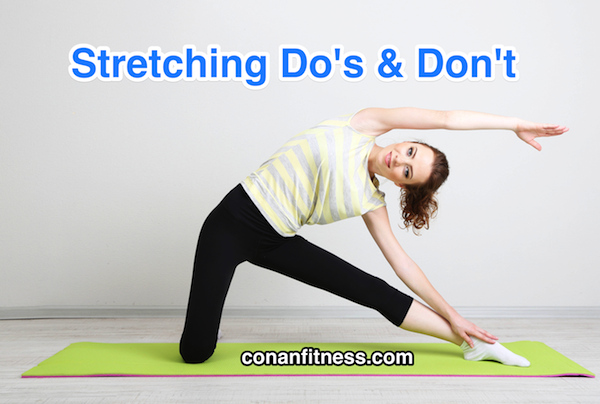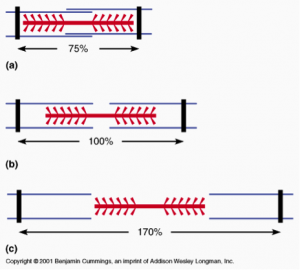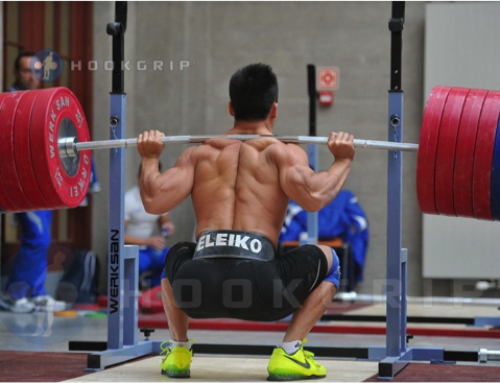During the 80’s there was plenty of talk about the benefits of a good warm up and stretch. Accompanying this was a lot of hype about stretching prior to competition or training helping with muscle soreness (DOMS), decreasing injury and improving performance. But since the 90’s we’ve known that this only happens when done correctly, at the right time and in conjunction with correct training, and that the effect is chronic, not acute, meaning the improvements happen as a training effect over time.
In fact, much evidence has arisen totally disproving much of the original claims and more data continues to emerge that shows that:
- old stretching protocols pre-training impedes performance
- prolonged stretching prior to exercise increases injury risk
- and static stretching pre-workout does not improve muscle soreness (DOMS)
Due to this more recent information you may have heard people now promoting not to stretch at all before training, particularly if a high degree of strength or power is required. However, you’ll often see high level athletes from gymnasts to olympic weightlifters engage in deep mobility work preceding their events which involve huge forces applied to the body. This can lead to confusion. So our aim here is to provide a better understanding of the science and relate it to simple training tips so you can get the most out of your entire fitness program.
Not All Sports Are The Same
The first thing to realise is that certain sports and activities require a much higher degree of flexibility to execute effective and efficient performance than other sports. Freestyle skiing, martial arts and gymnastics, for instance, not only need strength and power to deliver results but it often must be implemented at very deep joint ranges of motion. For example the knee and hip (often used in extension together) can be brought to very acute angles (like sitting at the bottom of a squat) sometimes with great forces applied to the body. They also require a very quick explosive stretch-shorten cycle. This is the myotatic reflex that makes a stretched muscle contract harder, just like the concept in plyometrics. So having good joint mobility before these events are undertaken is often necessary for optimal performance.
On the other hand, events like running and cycling rarely require the knee or hip to flex much more than a quarter squat, and they have a slow stretch-shorten cycle (unless sprinting), meaning it doesn’t require an explosive recoil in the muscle. Therefore, these sports don’t require a high degree of mobility work preceding the event and anything more than a gentle ballistic stretch can even be counterproductive in certain circumstances, making stretching beforehand less important than the previous examples.
What Does The Science Say?
Recent studies show that force production is decreased immediately after a muscle has been lengthened beyond its comfortable position. Along with this, risk factors for injury are increased and sports performance is negatively affected after acute stretching, with specific examples being:
- An examination into stretching effects on sprint times showed 15 minutes of passive stretching of hip flexor and extensors before repeated 40 metre sprints increased the runners trial times (were slower) compared to not stretching. (Wieman and Klee, 2000).
- Prolonged stretching of the plantar flexor muscle (calf) decreased the EMG firing activity (neural activity) and decreased the contractile force of the muscle. (Fowles et al. 2000).
- Knee extensor and flexor muscles were shown to decrease significantly in force production after stretching, both passive and actively when testing 1RM strength. (Kokkonen et al. 1998).
- Even ballistic stretching showed a slight decrease in force of the knee flexor and extensors (Nelson et al. 2001)
- Verticle jump performances were significantly lower following warmups with (PNF) stretching in them (Church et al. 2001).
- Force-endurance is also negatively affected. Stretching before a test for maximal repetitions in the hamstrings significantly reduced the number of well-coordinated movements. (Kokkonen et al. 1998).
The basic mechanisms underlying the reasons why force production is decreased post stretching is still being confirmed, but the points we do know are that:
- Passive stretching distends the muscle making it more compliant. This is simply a decrease in the natural tension within a muscle and is called ‘stress-relaxation’, which comes from holding a muscle in stretch at a constant length for a period of time, much like a weakened lacky band has less tension than one with strong elastic properties.
- A large part of muscle force development is the neural activation from the central nervous system and it is found that prior stretching decreases motor unit activation (the innervating nerves and units of muscle fibres within a muscle) along with Electromyogram activity (less nerve impulse) (Fowles et al. 2000).
- Stretching produces an acute depression in muscle spindle sensitivity (Avela et al. 1999). Muscle spindles are the sensory bodies within the muscle that detect length changes and cause the muscle to contract via the myotatic reflex we spoke of above.
Much of these physiological mechanisms and adaptations are the exact means by which we are able to make a muscle longer when we aim to become more flexible. These changes in themselves are not bad when aiming for long term mobility increases, in fact this is what we desire. But due to the lower neural activity to the muscle immediately post-stretching we have a dampened ability to produce force quickly, which actually means an increased risk of injury since most injuries happen when a muscle changes from eccentric (lengthening) to concentric (shortening) and if it is not strong/forceful enough it can easily tear at this point.
The key factor with stretching is knowing the difference between the short term acute effects of stretching and the chronic long term effects and how to optimise both.
Benefits Of Stretching
Done correctly and at the right time stretching is very beneficial for the following reasons:
- For most people having more flexibility is beneficial as they have a more free range of movement to work with and less internal resistance in most motions. Though the flexibility has to be appropriate, meaning balanced with the antagonist muscles and suitable for the muscle’s strength. For example, you can’t have long hamstrings if the hip flexors are really tight, and stretching them more is counterproductive until you bring the hip flexor length in balance with them, or likewise a really long muscle is not ideal if the muscle is weak. Long, strong and balanced with antagonist is what we’re after. Also, I say ‘most people’ because there are many others with hyper-flexibility already and these guys don’t want to stretch to make the muscles any longer than they are.
- Efficiency – movements requiring force at the ends of the range of motion are hampered by increased resistance when the muscles are particularly tight. So more mobility equals less resistance and hence less unnecessary energy cost. But movements that are typically well within the middle range of motion (like jogging) won’t improve efficiency from more and more flexibility work, in fact they can lose efficiency if hyper-flexibility makes the chassis less stable. Also, it has been shown that runners with the least flexibility in hamstring (and ‘sit-and-reach’ scores) had the best efficiency during distance runs due to the elasticity effect in the muscles, again, because they do not need to be put to the ends of their range of motion in running.
- Chronic vs Acute – Contrary to the negative effects we see in muscle strength immediately post-stretching (acute effects) there is actually an enhancement of strength following flexibility training long term. In the case of humans, gains in strength can be seen to occur after 3 weeks of flexibility training, without any specific training for strength development (Worrel et al. 1994) (Handel et al. 1997). This may be attributed to hypertrophy of the stretched muscles. Therefore, evidence suggests that, although stretching exercises may have a negative acute effect on strength, this may not be the case after chronic stretching.
- More actin/myosin crossbridges – The length-tension relationship of a muscle explains how the tension/force a muscle can actively produce is related to the length that the muscle is in at the time of contraction with a parabolic curve such as the diagram below showing the optimum length.

This explains that a ‘cramped up’ muscle at short length can produce less force compared to its ‘natural’ (neutral) length, and likewise an over-elongated muscle cannot produce much force either. The reason is because of the microfilament crossbridges within the muscle. The below diagram shows how actin and myosin, the filaments that make up the contractile elements of a muscle (the blue and red lines below), interact by linking to each other in ‘crossbridge’ binding sites (like the oars of a rowing team vessel) and contract to pull towards each other. The most amount of crossbridges (maximal force production) occurs at the ‘natural’ length where the total amount of myosin ‘heads’ can directly link with actin before too much or too little stretch negates their contact.

So, back to the chronic benefits of stretching. If you increase a muscle’s length over time you can achieve greater force production at longer ranges of motion due to the length being from organic growth within the muscle and not just from over-stretching to that point.
Here’s How To Do It Correctly
Here are the tips to apply this theory into your training for maximum advantage:
- Before training or competition put 90% of your focus on the Warm up (not the stretch)
- When you DO engage in the 10% stretching pre-game make sure it is mostly gentle ballistic stretching such as leg swings, progressive high kicks, arm swings or functional movements that open up the joints gradually. This is particularly so if you are engaging in those sports that do not require as much range of motion. If your sport does require this then engage in short, varied mobility exercises that do not keep the stretched muscle lengthened for too long.
- Only stretch warm muscles.
- If you are especially tight in a particular area you can focus a static stretch in that muscle since the risk of injury is probably more pertinent to the tightness than to the dampened strength as a result of the stretch. Getting balance is more important here and should be prioritised.
- Post workout is when you can stretch at length for flexibility.
- All other intense or lengthy stretching should be put on different days (or later in the day) to those that require the strength, or power or speed.
If you have any stretching related questions feel free to give us a shout and we’ll be happy to help you out.
Download Article: Stretching – The Do’s and Don’ts





